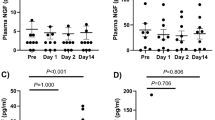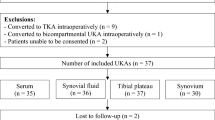Abstract
There is little information on the values of CRP and ESR as markers for inflammation in Unicondylar Knee Arthroplasty. The effect of periarticular steroid injection in post-operative pain relief and clinical recovery has not been well studied. Eighty-three consecutive patients undergoing primary UKAs were randomized to receive either an intra-operative periarticular injection with a local anaesthetic and adrenaline or with the addition of triamcinolone acetonide. CRP and ESR values, pain VAS and other scores, as well as clinical functional parameters, were obtained and analysed. Patients were assessed daily till discharge and up to 6 months post-operatively. Plasma CRP and ESR fluctuate after a UKA, with normalizing values indicating uneventful recovery. Periarticular steroid injections reduce post-operative pain and inflammation, and are clinically relevant as they improve short-term functional recovery and clinical parameters, resulting in better outcomes for patients without having major complications.



Similar content being viewed by others
References
Aalto K, Osterman K, Peltola H, Räsänen J (1984) Changes in erythrocyte sedimentation rate and C-reactive protein after total hip arthroplasty. Clin Orthop Relat Res 184:118–120
Ackland GL, Scollay JM, Parks RW, de Beaux I, Mythen MG (2007) Pre-operative high sensitivity C-reactive protein and postoperative outcome in patients undergoing elective orthopaedic surgery. Anaesthesia 62:888–894
Amin AK, Patton JT, Cook RE, Gaston M, Brenkel IJ (2006) Unicompartmental or total knee arthroplasty? Results from a matched study. Clin Orthop Relat Res 451:101–106
Bilgen O, Atici T, Durak K, Karaeminogullari O, Bilgen MS (2001) C-reactive protein values and erythrocyte sedimentation rates after total hip and total knee arthroplasty. J Int Med Res 29:7–12
Bonica JJ (1990) Postoperative pain. The management of pain, 2nd edn. Lea and Febiger, Philadelphia, pp 461–480
Busch CA, Shore BJ, Bhandari R, Ganapathy S, MacDonald SJ, Bourne RB et al (2006) Efficacy of periarticular multimodal drug injection in total knee arthroplasty. J Bone Joint Surg Am 88:959–963
Caracciolo B, Giaquinto S (2005) Determinants of the subjective functional outcome of total joint arthroplasty. Arch Gerontol Geriatr 41:169–176
Creamer P (1997) Intra-articular corticosteroid injections in osteoarthritis: do they work and if so, how? Ann Rheum Dis 56:634–636
DeWeese FT, Akbari Z, Carline E (2001) Pain control after knee arthroplasty: intraarticular versus epidural anesthesia. Clin Orthop Relat Res 392:226–231
Dutton AQ, Yeo SJ, Yang KY, Lo NN, Chia KU, Chong HC (2008) Computer-assisted minimally invasive total knee arthroplasty compared with standard total knee arthroplasty. A prospective, randomized study. J Bone Joint Surg Am 90:2–9
Dupont C, Rodenbach J, Flachaire E (2008) The value of C-reactive protein for postoperative monitoring of lower limb arthroplasty. Ann Readapt Med Phys 51:348–357
Fisher DA, Watts M, Davis KE (2003) Implant position in knee surgery: a comparison of minimally invasive, open unicompartmental and total knee arthroplasty. J Arthroplasty 18:2–8
Fuchs S, Rolauffs B, Plaumann T, Tibesku CO, Rosenbaum D (2005) Clinical and functional results after the rehabilitation period in minimally-invasive unicondylar knee arthroplasty patients. Knee Surg Sports Traumatol Arthrosc 13:179–186
Kardash KJ, Sarrazin F, Tessler MJ, Velly AM (2008) Single-dose dexamethasone reduces dynamic pain after total hip arthroplasty. Anesth Analg 106(4):1253–1257
Koskinen E, Eskelinen A, Paavolainen P, Pulkkinen P, Remes V (2008) Comparison of survival and cost-effectiveness between unicondylar arthroplasty and total knee arthroplasty in patients with primary osteoarthritis: a follow-up study of 50, 493 knee replacements from the Finnish Arthroplasty Register. Acta Orthop 79:499–507
Laiho K, Mäenpää H, Kautiainen H, Kauppi M, Kaarela K, Lehto M, Belt E (2001) Rise in serum C reactive protein after hip and knee arthroplasties in patients with rheumatoid arthritis. Ann Rheum Dis 60:275–277
Lombardi AV Jr, Berend KR, Mallory TH, Dodds KL, Adams JB (2004) Soft tissue and intra-articular injection of bupivacaine, epinephrine and morphine has a beneficial effect after total knee arthroplasty. Clin Orthop Relat Res 428:125–130
Manzotti A, Confalonieri N, Pullen C (2007) Unicompartmental versus computer-assisted total knee replacement for medial compartment knee arthritis: a matched paired study. Int Orthop 31:315–319
Mäenpää H, Laiho K, Kauppi M, Kaarela K, Kautiainen H, Lehto MU, Belt EA (2002) A comparison of postoperative C-reactive protein changes in primary and revision hip arthroplasty in patients with rheumatoid arthritis. J Arthroplasty 17:108–110
Mont MA, Stuchin SA, Paley D, Sharkey PF, Parvisi J, Tria AJ Jr, Bonutti PM, Etienne G (2004) Different surgical options for monocompartmental osteoarthritis of the knee: high tibial osteotomy versus unicompartmental knee arthroplasty versus total knee arthroplasty: indications, techniques, results, and controversies. Instr Course Lect 53:265–283
Pang HN, Lo NN, Yang KY, Chong HC, Yeo SJ (2008) Periarticular steroid injection improves the outcome after unicondylar knee replacement: a prospective, randomized controlled trial with a two-year follow-up. J Bone Joint Surg Br 90:738–744
Altman RD, Hochberg MC, Moskowitz RW, Schnitzer TJ (2000) Recommendations for the medical management of osteoarthritis of the hip and knee. Arthritis Rheum 43:1905–1915
Reddy PD, Zelicof SB, Ruotolo C, Holder J (1995) Interdigital neuroma. Local cutaneous changes after corticosteroid injection. Clin Orthop Relat Res 317:185–187
Repicci JA (2003) Mini-invasive knee unicompartmental arthroplasty: bone-sparing technique. Surg Technol Int 11:282–286
Romanowski MR, Repicci JA (2002) Minimally invasive unicondylar arthroplasty: eight-year follow-up. J Knee Surg 15:17–22
Smith C, Erasmus PJ, Myburgh KH (2006) Endocrine and immune effects of dexamethasone in unilateral total knee replacement. J Int Med Res 34:603–611
Thebault J, Blatrix C, Blanchard J, Panak E (1982) A possible method to control prolongations of bleeding time under antiplatelet therapy with ticlopidine. Thromb Haemost 48:6–8
Tria AJ Jr (2007) Minimally invasive total knee arthroplasty; past, present and future. Am J Orthop 36:6–7
Tria AJ Jr (2003) Advancements in minimally invasive total knee arthroplasty. Orthopedics 26:s859–s863
Volpi P, Marinoni L, Bait C, Galli M, Denti M (2007) Lateral unicompartmental knee arthroplasty: indications, technique and short-medium term results. Knee Surg Sports Traumatol Arthrosc 15:1028–1034
Walton NP, Jahromi I, Lewis PL, Dobson PJ, Angel KR, Campbell DG (2006) Patient-perceived outcomes and return to sport and work: TKA versus mini-incision unicompartmental knee arthroplasty. J Knee Surg 19:112–116
White J, Kelly M, Dunsmuir R (1998) C-reactive protein level after total hip and total knee replacement. J Bone Joint Surg Br 80:909–911
Yang KY, Wang MC, Yeo SJ, Lo NN (2003) Minimally invasive unicondylar versus total condylar knee arthroplasty–early results of a matched-pair comparison. Singapore Med J 44:559–562
Author information
Authors and Affiliations
Corresponding author
Rights and permissions
About this article
Cite this article
Ng, Y.C.S., Lo, N.N., Yang, K.Y. et al. Effects of periarticular steroid injection on knee function and the inflammatory response following unicondylar knee arthroplasty. Knee Surg Sports Traumatol Arthrosc 19, 60–65 (2011). https://doi.org/10.1007/s00167-010-1126-0
Received:
Accepted:
Published:
Issue Date:
DOI: https://doi.org/10.1007/s00167-010-1126-0




